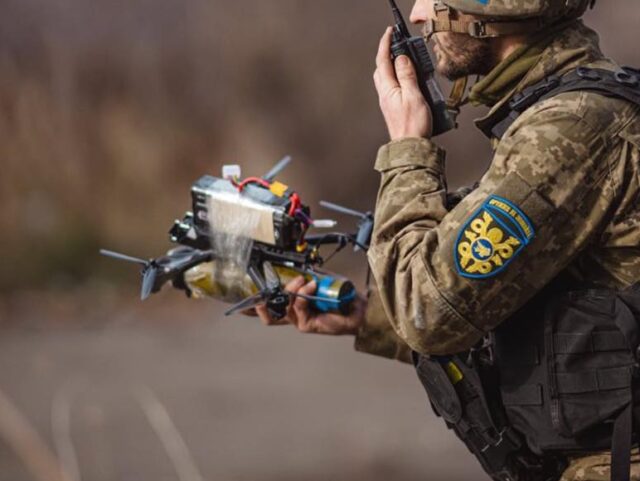Volodymyr Zelensky says Ukraine will build one million ‘suicide drones’ in 2024, also known as loitering munitions, the emerging weapons system that appears to be the major technological and tactical revolution coming out of the war.
The vow to massively ramp up the production of killer drones in 2024 was made by President Zelensky in his end-of-year press conference this week. Speaking to press in Kyiv, he said: “I am positive about increasing our drone production and about the formation of specialized units… As for production, we are making one million drones next year. We will make a million. We will do everything to make it so, and I know that it will be so.”
Ukraine has been producing increasing numbers of drones since the start of Russia’s renewed invasion in 2022, and also imports considerable numbers from around the world. Following Zelensky’s remarks Ukraine’s Minister of Strategic Industries Oleksandr Kamyshin — widely feted in Western media as the head of Ukraine’s railways in the early days of the war — boasted the nation would produce “more than 50,000 FPV drones” in December of this year alone. If true, the claim suggests Ukraine is indeed well on its way to producing a million of the ‘kamikaze’ type drones in 2024.
Booom!
There was russian TOS-1A "Solntsepyok", which costs $15 mln, but a $400 FPV drone blew it up.📹: 59th Motorized Brigade pic.twitter.com/3js4pngbSo
— Defense of Ukraine (@DefenceU) October 22, 2023
Kamyshin said in addition to the large numbers of these small, single-use killers, Ukraine would also produce over the course of 2024: “more than 10,000 medium-range (hundreds of kilometres) attack drones and 1,000+ drones with a range of over 1,000 kilometres”.
The First Person View (FPV) drones of which Zelensky and Kamyshin speak have become an integral, conflict-defining weapon, with social media flooded with hundreds of videos of successful attacks by the agile flying bombs deployed by both sides. While many of those videos — which often show the attack from the perspective of the drone itself and the moment of impact and aftermath from a distant spotter drone with musical accompaniment — are too gruesome for publication, some published by official Ukrainian channels show strikes against Russian vehicles, weapon systems, and emplacements.
Pictures shared by Ukraine show a typical FPV drone setup, with a relatively lightweight commercial hobbyist drone strapped to a small munition like a grenade or mortar round. The pilot wears live video goggles, giving him that ‘first person’ perspective of the drone. While the term ‘loitering munition’ may have been coined with considerably larger, longer-range, and more expensive defence company-built drones in mind, the use of small and inexpensive homebrew versions has become common in the conflict.
Ukrainian statements about the drones frequently emphasise how cheap the drones are — a few thousand dollars each — versus the cost of the weapon systems and armoured vehicles they take out, in the many millions of dollars, underlining the asymmetric nature of the development.
Newsweek magazine wrote in praise of the weapons this week, citing a Ukrainian government minister calling them a “game-changer” and “sometimes even more [efficient] than artillery… a tech revolution”.
Today, this Dnipro TDF Brigade's FPV drone flight is just for training.
But tomorrow, the explosive charges will be connected, and perhaps we will hear some good news about "claps" (so Russian propaganda calls explosions) on enemy positions. pic.twitter.com/6ggT41AdUB— Ukraine Territorial Defense Forces (@TDF_UA) September 8, 2023
A Ukrainian FPV drone vs a russian machine gunner
1:0
And there will be no rematch.📹: 58th Motorized Brigade pic.twitter.com/VHYvugkW4L
— Defense of Ukraine (@DefenceU) October 26, 2023
Underlining the degree to which Ukraine is placing bets on drones are claims earlier this month that Ukraine is now “churning out” thousands of newly minted drone pilots from privately operated schools across the country. On the operation of FPV drone teams, DefenceOne reports:
…it takes longer to learn to fly them than, say, the hardware-and-software-stabilized photography quadcopters used across Ukraine’s frontline to coordinate artillery.
“You are literally flying this drone like it was a Cessna [plane] from the 1960s,” said Dvoretskyi.
To simplify the task, FPV drones typically fly in airborne teams with photography drones that sport a wider range of view and advanced zoom lenses. The operators of the photo drones mark the GPS coordinates of Russian vehicles and soldiers for the FPV pilots… The most talented pilots are used to playing computer games, he said. People with “PlayStation experience” do better, Dvoretskyi agreed.
While the drones have proven very effective in the Ukraine war, there is little doubt they are a contributing factor towards the grinding stalemate the conflict appears to have arrived at. The reasons for this were discussed by Ukraine’s top general, who explained that attempts at gaining the initiative through surprise assaults are basically now impossible as battlefield intelligence, saturated by cameras and sensors as it now is, is so good.
General Valery Zaluzhny said in November: “There will most likely be no deep and beautiful breakthrough… The simple fact is that we see everything the enemy is doing and they see everything we are doing.”
Asymmetric Warfare: Ukraine Shows Off Home-Grown Sea Drones Used to Attack Bridges, Ships https://t.co/oybQsvlSSq
— Breitbart London (@BreitbartLondon) August 17, 2023

COMMENTS
Please let us know if you're having issues with commenting.